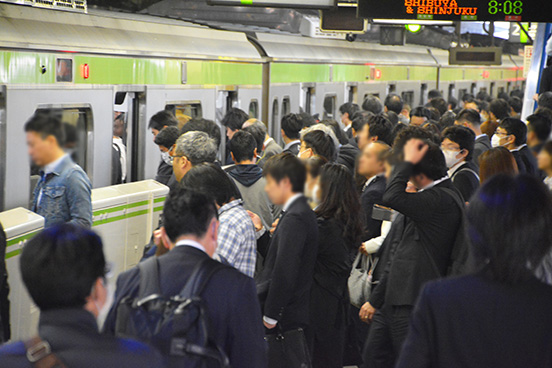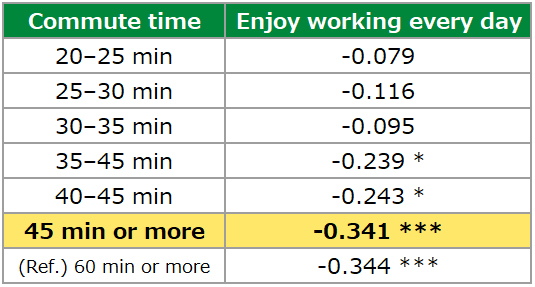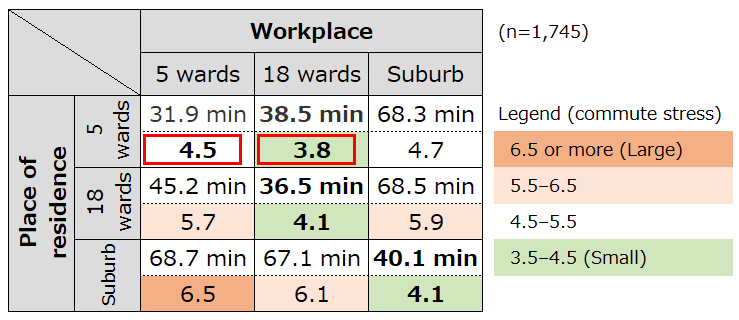Commute of Less than 45 Minutes May Be Key to Joyful Working—Let's Re-examine Stressful Commute during Telework Days

Telework Days, a campaign that encourages companies and organization nationwide to adopt various workstyles, such as telework, staggered hours, and flex time, will be carried out between July 22 and September 6, 2019.
This initiative, which was initiated by the Ministry of Internal Affairs and Communications, the Ministry of Economy, Trade and Industry, etc., is aimed at alleviating traffic congestion during the 2020 Olympic and Paralympic Games in Tokyo. During the Games, it is estimated that railway users in the Tokyo metropolitan area during morning commute (7 a.m. –10 a.m.) will increase by around 10% compared to normal times*1. If no measures are taken, this may have an effect not only on the administration of the Games but also on the commute of workers working in Tokyo as well as on corporate activities.
In fact, commute from metropolitan areas to the city center normally involves long hours on trains at capacity or double the capacity. This had led to concerns of physical and time exhaustion as well as social loss such as a drop in productivity as a result of such exhaustion. Avoiding stressful commute through telework should not only have social significance but also prove beneficial to individual workers and thus to companies.
Then, what kind of effects can be expected through telework by reducing commute time or avoiding riding packed trains? We analyzed the results of the Office Worker Survey 2019 that Xymax Real Estate Institute conducted in February 2019 from the perspective of commute time and found two interesting trends.
- *1 Source: “2020 TDM Promotion Project: To Ensure Both Transportation for the 2020 Games and Corporate Activities” Tokyo Metropolitan Government
1.Loss due to long commute
First, we examined the effect of the length of commute time on workers' motivation and engagement. An analysis of the impact of commute time on multiple elements such as “job satisfaction,” “joy in working,” and “sense of belonging to the place of work” using a statistical method indicated that there was a significant impact on “joy in working.”
The following table shows the relationship between commute time from home to the workplace*2 and the percentage of workers who feel they “enjoy working every day.” The more the number of asterisks there are, the more statistically significant (reliable) the impact is. Figures below zero mean that the commute time has a negative impact on the percentage of workers who feel they enjoy working every day. In this survey, a negative impact can be seen in a commute time of 35 minutes or more, with the impact becoming more significant for 45 minutes or more.
This means that a commute time of 45 minutes or more lowers the percentage of workers who feel they enjoy working every day.
- *2 The door-to-door commute time (one way) between home and workplace using the respondent's usual means of commute (e.g. train, bus, car, bicycle, foot).
Table 1: Impact of Commute Time on Percentage of “Enjoy Working Every Day”

2.Commute to five urban wards is highly stressful even if distance is short
In addition to the length of commute time, we focused on the combination of the place of residence and the workplace: in other words, the direction of the commute. In this survey, we found that stress from commute*3 was proportional to the length of commute, but the manifestation of stress differed depending on the direction of the commute.
- *3 The figure of commute stress expressed in a range of 0 (smallest) to 10 (largest)
The table below indicates the average commute time and average commute stress of each combination of place of residence and workplace for the following three Tokyo metropolitan areas: (1) Five central wards (Chiyoda, Chuo, Minato, Shinjuku, Shibuya wards); (2) 18 wards (the 23 wards of Tokyo excluding the five central wards); and (3) Suburb (entire Tokyo metropolitan area excluding the 23 wards of Tokyo).
Table 2: Average Commute Time (Upper Row) and Average Commute Stress (Lower Row) by Place of Residence and Workplace

As the table shows, the groups of respondents living in the 18 wards and in the suburbs had the shortest commute within the same area, with proportionally small commute stress. This implies that the proximity between home and work is effective in reducing commute stress. Furthermore, the commute time of both areas is less than 45 minutes, which is within the range where the percentage of workers feeling they enjoy working is not impaired.
However, the group of respondents living in the five central wards tended to show smaller stress when commuting to the 18 wards, which requires longer time, rather than when commuting within the same area, which is the shortest commute. In addition, the group of respondents residing in the 18 wards did not show a proportionate relationship between stress and commute time, with the difference in stress remaining at 0.2, even though commute to the suburbs required 23 more minutes than when commuting to the five central wards.
These indicate that commute from the periphery to the city center may result in greater stress than commuting to the opposite direction. Since most of the offices in the Tokyo metropolitan area are currently concentrated in the city center, trains going to the city center are uniformly congested, generating painful commute and letting commuters feel stress regardless of the length of commute.
3.Diverse types of workplaces in the suburbs are a key solution to eliminating stressful commute
The above two analyses indicate that commuting for less than 45 minutes toward the periphery enables commuters to enjoy working with reduced commute stress. However, it is not easy and practical to move offices in the city center to the suburbs or to ask employees to move to the city center.
Then, what becomes effective is to provide a wide range of workplace options in the periphery, in addition to offices in the city center. These include establishing satellite offices that are owned or rented by the company and using shared office services, which are provided by specialized providers. Shared office services, in particular, have seen a variety of new services in recent years that allow flexible use in terms of time and size, such as a pay-per-use system and a monthly fee system, lowering the hurdle for companies to introduce.
The use of such workplaces is encouraged in Telework Days, and the number of service providers and local governments registered as supporting organizations has amounted to more than 160*4. This year's Telework Days, which is considered a trial for the 2020 Tokyo Games, may be a good opportunity to try out ways to eliminate employees' stressful commute.
- *4 Only organizations providing workspace. (As of July 3, 2019) Source: Official website of 2019 Telework Days.

